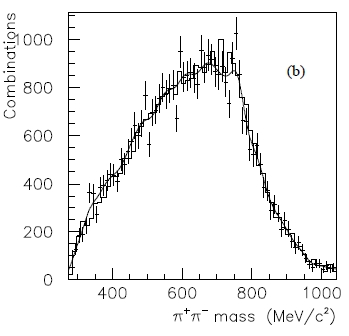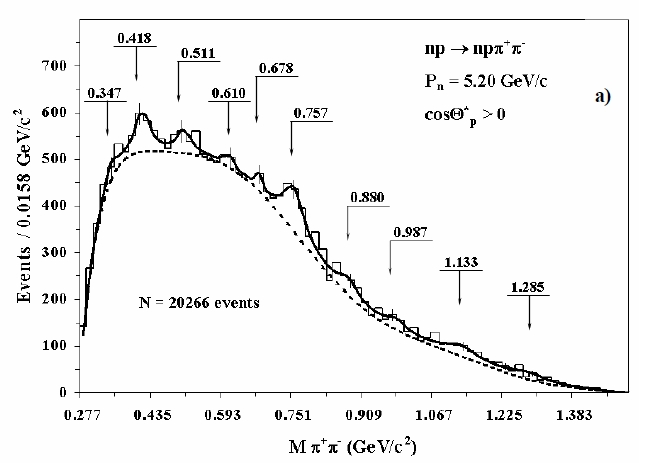Old data may well still hold in custody surprising things that we have yet to unearth: in the course of the last 70 years physicists have produced collisions between hadrons in a number of ways, inside detectors of all kinds. And while of course we cannot ex post improve the detecting devices with which those data were collected, we have in our hands today more computing power in a 30-bucks cell-phone than we had thirty years ago in a large experiment.
The corollary is that it may make sense to look back at old data, in search of surprises. But there is a catch: if you are going to do that, you have better try using the knowledge we have picked up in the meantime: if you do not, your work cannot be taken very seriously. The other catch is that it may require you to copy by hand data which is only archived in printed form, as is the case I am going to describe here!
The Narrow Resonance at "About 755 MeV"
The Cornell arxiv is, as always, the source. In a preprint appeared there a few days ago prof. Mario Gaspero, from University of Rome "La Sapienza" (a place ripe with highly distinguished physicists) claims the observation of a narrow resonance in antiproton-neutron collisions produced in 1970! Let us have a closer look.
The announcement appears to be not new -the paper is a writeup of a talk given in November 2009. However, I think I can be excused for having overlooked a talk on hadron spectroscopy held in Tallahassee. Less excusable is having missed basically the same information when it first appeared one year ago, in a previous preprint. Never mind -I can be a monster with a thousand eyes when I play chess, much less so when I browse preprints.
But what is this all about, after all ? Okay, I will describe it in short, but first let me quote from the Abstract:
"A narrow peak in the pi+/pi- mass distribution was seen by the Rome-Syracuse Collaboration inannihilation at rest in 1970. It was ignored for 40 years."
I think that this remark sets the stage. Letting go with qualitative, grudge-bearing sentences like "it was ignored for 40 years" in the abstract of a single-authored paper is, in my humble opinion, an indicium that something is not kosher. From now on, the mind of a bastard like me opens a parallel processor during the reading: one which constantly tries to find other "crackpot" hints.
The abstract continues as follows:
"The reanalysis of this peak finds that it has the mass 757.4 [...] MeV and a width consistent with the experimental resolution. The evidence of the peak is 5.2 standard deviations. [...]"
Okay, there was an analysis, so this is a re-analysis. This to me means that the signal was not "ignored for 40 years". But it is interesting, and so the paper deserves to be read.
The data comes from a collaboration which studied the decay of the omega into two pions, using the Brookhaven National Laboratory's 30-inch bubble chamber. According to the author,
"in 1970, the Rome-Syracuse Collaboration (RSC) [...] found an unexpected result: the pi+ pi- mass distribution of 1496 annihilations at rest [...] had a narrow peak at about 755 MeV. This distribution is shown in Fig.1a. A chi^2 fit of this distribution found that the peak had a significance of about 4.5 standard deviations and a width lower than the experimental resolution. No relation was found between the pi+ pi- and other angular and mass distributions. These facts suggested to the RSC that the peak was generated by a fluctuation."
For those of you who are already feeling they are in the dark, let me explain in simple terms what this is about. First of all, while today we create millions of proton collisions per second at ultra-TeV energies to understand the structure of matter at the shortest distance scales, and use detectors that are allegedly the most complex creations of mankind ever, forty years ago we used collisions at energies of few GeV -the equivalent of a few proton masses- and inspected each collision within the volume of a vessel filled with liquid, by taking pictures at the trails of bubbles left by the charged particles produced in the collisions.
As for the "chisquare fit" and the "4.5 standard deviations": this is experimental physicist's jargon, to say how a mass distribution such as the one below may be approximated by a smooth curve, and suggest the presence of a significant feature. 4.5 standard deviations occur by chance as a random fluctuation of the background only a few times every million trials. Such a rarity is usually sufficient to claim that the feature is real, but this, crucially, assumes that one knows extremely well how the background is distributed.
Finally, the width. A short-lived particle has a finite width, but if the detector resolution is not good enough, the resonance curve in the mass distribution will look like a Gaussian shape with sigma equal to the resolution. If, however, a bump is found with a width significantly smaller than the experimental resolution -as appears the original observation in our case-, this cannot in any way be a resonance.
Professor Gaspero however feels compelled to investigate the effect in more depth. He continues by explaining that only by the early 1990s the properties of baryon annihilations started to get understood better, such that a prediction for the mass distribution -the background!- could be drawn on top of the 1970 data.
 This is shown in the figure on the left, with dashes (ignore the leftward dot-dashed "phase-space" distribution, which only shows how the data would distribute if QCD had nothing to do with the interaction). The histogram represents the experimental data: it seems that the three-bin bump at 755 MeV does not agree with the dashes... But it does not look like a 4.5 standard deviation thing! To get 4.5 standard deviations, you have to forget the background shape prediction, and perform a narrow-range polynomial plus Gaussian fit (the full curve). The dots show how the polynomial alone behaves.
This is shown in the figure on the left, with dashes (ignore the leftward dot-dashed "phase-space" distribution, which only shows how the data would distribute if QCD had nothing to do with the interaction). The histogram represents the experimental data: it seems that the three-bin bump at 755 MeV does not agree with the dashes... But it does not look like a 4.5 standard deviation thing! To get 4.5 standard deviations, you have to forget the background shape prediction, and perform a narrow-range polynomial plus Gaussian fit (the full curve). The dots show how the polynomial alone behaves.Anyway, let us follow the paper:
"A year after the communication of the preliminary results of this analysis, the OBELIX collaboration presented the preliminary results of the analysis [...]"
OBELIX was a similar experiment. It studied a quite similar reaction which should have produced the same new particle.
 An overlay of the RSC and OBELIX mass spectra normalized to each other is shown on the right. The author notes that
An overlay of the RSC and OBELIX mass spectra normalized to each other is shown on the right. The author notes that"At that time, the absence of the peak in the OBELIX data confirmed the opinion that the RSC peak was a fluctuation".
So is this a fluctuation, after all ? One experiment sees a bump in an otherwise allegedly smooth distribution, this appears significant but not overly so, and another experiment does not see anything. Where is the crackpot index going to point at, in the end ?
The verdict
I will save you a mass of considerations I could line up about the contents of the paper, the way the data is analyzed, and the fits that are performed on the mass distribution. Those of you who are interested in my opinion are for sure the same ones who might get their own by reading the article; the others would just get bored by my pedantry. So I will jump to my own conclusions.
In the end, I believe professor Gaspero is innocent of the charges we have piled up against him. While the article may be written in a slightly non-conventional way, and while his fits are all way less than convincing, he does have a point. The reason is to be found in another paper, which he mentions in his own:
"Recently, Troyan et al. claimed to have observed several narrow pi+ pi- peaks in the reactionwith neutrons of 5.2 GeV/c. One of these peaks has a mass close to 755 MeV. The coincidence of the mass of the RSC peak with that of Troyan et al. suggested to reanalyse the RSC data."
Indeed, by checking the reference, one finds a nice mass distribution, where Troyan et al. imaginatively fit no less than 10 new resonant states of charged pion pairs! It seems far-fetched to believe these are all honest-to-god resonances, but in truth the bump sitting at 755 MeV is one of the most significant ones -it does look like a hadronic particle of small width.

Above is the relevant figure. Admittedly, the "freedom fit" (one would usually call such smooth curves interpolating perfectly all the data points a "french fit", but let us this time to pay homage rather than mock our french friends) is a bit imaginative... But who knows: there are a lot of mysteries in low-energy quantum chromodynamics!
Gaspero in his paper tries to convince us that the excess observed by RSC at 755 MeV is significant enough to be considered a new particle. He estimates the significance of the observation in a way which is rather objectionable, but I do not wish to criticize such small prints. The particle may be there, or it may not. The problem, to me, is another. I sense, or imagine thanks to my fervid imagination, that this paper is written to get revenge rather than to claim a discovery which, leave alone belated, is not even a "first observation" -since if the particle is there, Troyan and collaborators are to be credited. Revenge from colleagues who did not believe the new particle 40 years ago. Am I right ? I do not know, and I do not wish to sound disrespectful to my colleague in Rome, so I will stop my conjectures here.
The problem is that the existence of these low-energy hadronic bound states does little to further our understanding of strong interactions, at least as long as they remain just mass peaks of unknown properties. Alas, we cannot predict them nor calculate their properties with the existing theoretical tools. If you let me take a radical stand, we need more theoretical ideas here! Lattice QCD may come to the rescue, but I believe there still are rough edges to smoothen there.
To conclude, I do not know if I learned something meaningful today, but I enjoyed reading this paper. And I imagine that in 2050 somebody from the OBELIX collaboration will come up with an explanation of why they did not, in fact, see the 755 MeV resonance... Stay tuned, but get yourself a comfortable chair!





Comments